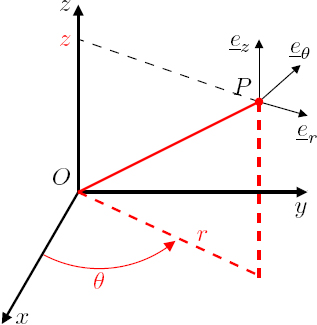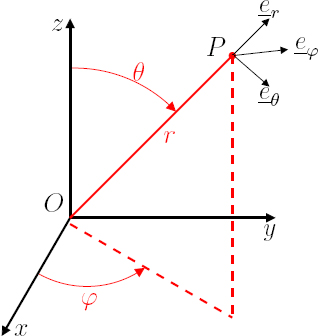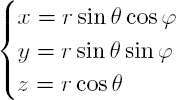Appendix 1
Developments in Cylindrical and Spherical Harmonics
The use of cylindrical or spherical coordinates simplifies the resolution of equations that govern propagation in structures with axial or spherical symmetry. In this appendix, we establish the solutions to the Helmholtz equations in these two curvilinear coordinate systems.
A1.1. Cylindrical harmonics
Let Rc be the reference frame of cylindrical coordinates (r, θ, z) and center O. The Cartesian coordinates are then defined in terms of the cylindrical coordinates by the relations:
Considering expression [A1.7] for the Laplacian in cylindrical coordinates given in Appendix 1 of Volume 1, the Helmholtz equation is written with M = L or T, depending on the type of wave:
The solution to this equation is found using the separation of variables method:

Substituting this trial solution into equation [A1.2] and dividing by RΘZ leads to:
The third term is a function of the variable z only, while the rest depends on r and θ. It is necessarily equal to a constant (−k2), leading to equation:
whose solutions are of the type:
The same reasoning applied to the second term of equation [A1.4], which is written as:
leads to the equation:
where n is a constant. The solutions of this equation are:
Since the domain of study is defined for θ [0, 2π], n is necessarily an integer, so that the field is continuous at θ = 0 and at θ = 2π.
After the substitution, equation [A1.7] takes the form of the Bessel equation:
whose general solution is:
where Jn and Yn are Bessel functions of the first and second kind, respectively. The solution Rn(k⊥r) can also be expressed by:
where ![]() are the Hankel functions defined by:
are the Hankel functions defined by:
The derivatives of the Bessel and Hankel functions verify the recurrence relations:
For x = 0, the function J0 takes the value 1, while the other Jn functions are zero and the Yn functions are all singular. The Hankel functions are also singular at the origin and have the specific feature that in the far field, they approach the functions:
The potential is sought in the form of an expansion on the cylindrical harmonics:
If the problem is independent of the z coordinate, the wave number k is zero and k⊥ = kM; the potential of the mode M is then expressed by:
The developments of the exponential of a trigonometric function, given by Jacobi and Anger:
can be used, for example, to represent a phase-modulated wave or to convert a plane wave into a sum of cylindrical harmonics. These identities are deduced from the generating functions of the Bessel functions:
Since i−nJ−n(x) = inJn(x), the second equation [A1.18] takes the form:
A1.2. Spherical harmonics
Let Rs be the reference frame of spherical coordinates (r, θ, ϕ) and center O. The Cartesian coordinates are then defined as a function of the spherical coordinates through the relations:
Considering expression [A1.16] for the Laplacian in spherical coordinates, given in Appendix 1 of Volume 1, the Helmholtz equation is written in spherical coordinates as:

The solutions are found using the separation of variables method:
which, after dividing by RΘΦ, leads to the equation:
Multiplying by r2 sin2 θ shows that the third term depends only on ϕ, while the rest depends on r and θ. Consequently, Φ satisfies the following equation:
whose solutions are:
to ensure continuity over the domain ϕ ∈ [0, 2π].
Considering this solution, equation [A1.24] takes the form:
Multiplying by r2 shows that the first and fourth terms depend only on r, while the second and third terms depend only on θ; equation [A1.27] can be divided into two parts1:
By changing the variable X = cos θ, the θ equation takes the form of an associated Legendre equation:
Its solutions are the Legendre functions of degree n and order m:
which are derived from the Legendre polynomials of degree n (Pn) through a derivative of order m:
If the problem is invariant with respect to the angle ϕ, m = 0 and the solution to equation [A1.29] is a Legendre polynomial of degree n: Pn(cos θ).
By performing the change in variable x = kr, equation [A1.28] in r is written as:
The change in function ![]() leads to the Bessel equation [A1.10] for the index n + 1/2:
leads to the Bessel equation [A1.10] for the index n + 1/2:
Its solutions are Bessel functions of the first and second kind of fractional order:
The Rn(kr) functions are thus expressed by:
where the spherical Bessel functions of the first kind, jn, and the second kind, yn, are defined by:
In some cases, it is preferable to introduce the spherical Hankel functions:
to express the function Rn(kr):
A1.2.1. Properties of spherical Bessel and Hankel functions
The derivatives of the spherical Bessel and Hankel functions satisfy recurrence relations identical to [A1.14]:
At x = 0, the function j0 takes the value 1, while the other functions, jn, are zero and the yn functions are singular. It follows that the Hankel functions are also singular at the origin and their asymptotic behavior in the far field:
is that of a divergent wave for ![]() and a convergent wave for
and a convergent wave for ![]()
A1.2.2. Properties of Legendre functions
The associated Legendre functions verify the orthogonality relation:
If m and μ are non-zero, they also verify the relation:
Two other relations involving the Legendre functions are also useful:
and
A1.2.3. Expansion on spherical harmonics
Any scalar function that is a solution to the Helmholtz equation can be developed as an infinite sum of modes:
called normalized spherical harmonics:
The amplitudes An,m of the spherical harmonics are deduced from the boundary conditions. The functions Yn,m(θ, ϕ) are orthogonal and normalized functions; they verify the relation:
A development in spherical harmonics, very useful for acoustic scattering problems, is that of a plane wave propagating in the z direction:


































